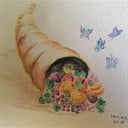What everyday cooking ingredient is Alfred Bird credited with inventing?
Baking powder was discovered by English food manufacturer Alfred Bird in 1843.
It is used instead of yeast for end-products where fermentation flavours would be undesirable or where the batter lacks the elastic structure to hold gas bubbles for more than a few minutes, or to speed the production. Because carbon dioxide is released at a faster rate through the acid-base reaction than through fermentation, breads made by chemical leavening are called 'quick breads'.
Baking powder works by releasing carbon dioxide gas into a batter or dough through an acid-base reaction, causing bubbles in the wet mixture to expand and thus leavening the mixture.
Most commercially available baking powders are made up of sodium bicarbonate (also known as baking soda or bicarbonate of soda) and one or more acid salts. Typical formulations (by weight) call for 30% sodium bicarbonate, 5-12% monocalcium phosphate, and 21-26% sodium aluminum sulfate. The last two ingredients are acidic: they combine with the sodium bicarbonate and water to produce the gaseous carbon dioxide. The use of two acidic components is the basis of the term "double acting." Another typical acid in such formulations is cream of tartar, a derivative of tartaric acid. Baking powders also include components to help with the consistency and stability of the mixture.
Commercial baking powder formulations are different from domestic ones, although the principles remain the same.
More Info:
en.wikipedia.org













